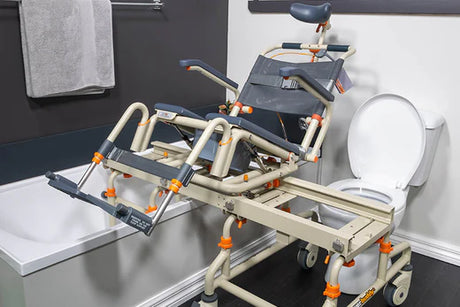A disability can be health related, resulting from a pre-existing condition, or experienced following an injury. At some point, the decision is made around equipment and assistive support in the home, including bathroom. Often at this stage permanent modification to the bathroom is suggested and considered.
Perhaps you’re reading this also at a crossroads with how to best set the home up to support your disabled loved one. In this article we’re going to provide some insights into why bathroom modification may not be the best option.
Modifying A Bathroom Is Expensive
If you’ve looked into upgrading a bathroom for mobility and access, you will have likely been shocked at the cost this can demand. Depending on the level of modification required, many households end up spending well into the tens of thousands. Costs associated with the installation include the labour, assessment and equipment.
In some countries, public health systems have schemes to assist with mobility costs. However, these are typically capped at a certain amount, meaning that additional modification and equipment over the cap will fall squarely on the user or their family’s shoulders. And in some countries, there is a portion of the available funding that is income tested, meaning you may not even get the full amount available.
Likewise, getting modifications through insurance is possible, but again the total amount of such a bathroom upgrade, particularly for someone with advanced support needs, may be outside set thresholds.
Renovation Takes Time
Have you ever undertaken renovations to your home? If you have, you’ll know it’s far from an overnight process. In fact, the complexities of modifying a bathroom such as navigating around plumbing and electrical fixtures, along with a variety of wall and floor materials can mean modification can take weeks to put in place.
This might not be as problematic in a home with multiple bathrooms, but any household sharing only one main bathroom will find this huge inconvenience. And what happens when unforeseen issues crop up like finding rotten timber or unstable tiling on the wall? The renovation can suddenly turn into over a month (and bring about some extra expenses to have the bathroom fit for modification).

Permanent Fixtures Can’t Be Changed Easily
Many of those within the mobility community have evolving needs over time; be it growing, rehabilitation or reduction in mobility over time. A bathroom modification with grip bars, access and transfer may be set up properly for the user today, but what about in 2, 5 or even 10 years? Making adjustments to a bathroom’s accessibility features is going to be a process of finding replacement parts, removing the old fixtures and installing the new ones – plus any patching up of holes left by old fixtures.
Without the ability to move things around, the mobility imparired user ends up working around the equipment – rather than the other way around. We believe strongly that users’ support equipment should adjust to their needs.
And what happens when you want to move to a new home? Pulling out fixtures and moving them to a new home is going to come with effort and cost – in both homes.
Other Bathroom Users In The Household
With hundreds of thousands of disabled individuals globally who live with their families, partners or flatmates, it’s fair to consider others’ bathroom experience too. With advanced modification of a bathroom, everyone in the home will need to navigate around installed equipment and fixtures. While we’re sure families and friends are happy to accommodate this, it does beg the question of why permanent modification is the right move when there is another way to go about bathroom mobility.

It may not even be necessary (here’s why)
Imagine if you got all the benefits of bathroom mobility equipment, but could remove any sign of this from the bathroom in a matter of moments? What if mobility impaired users could access most standard bathrooms with comfort, dignity and ease, while allowing their family to also enjoy the bathroom totally uninterrupted? And what if this cost a fraction of permanent housing modification?
That’s exactly what the Showerbuddy range offers. We’ve spent years developing and refining bathroom transfer products that bring premium quality and function to most bathrooms across the globe. Our range caters for different types of showers, providing a level of customisability through our accessories that makes using the bathroom enjoyable for our users.

Want to know if Showerbuddy can help you avoid permanent modification to your bathroom?
There’s a better, more affordable way to get freedom in the bathroom as a mobility impaired individual. If you’re interested in finding out whether Showerbuddy is right for you, your client or your family member, get in touch with our team. We have a global network of distributors to help you find the right Showerbuddy solution for you.
Further Reading
- Housing modifications for disabled people – Ministry Of Health, New Zealand
- How Much Does It Cost Disability Remodeling? – Fixr
- Home adaptations – NHS UK
























![Toilet Training A Young Child With Mobility Challenges [And How A Shower Chair Can Help]](http://shower-buddy.com/cdn/shop/articles/toilet-training-disabled-child_520x500_a90e5234-d372-435d-aa56-8da15dd3836c.webp?v=1722557239&width=460)


























